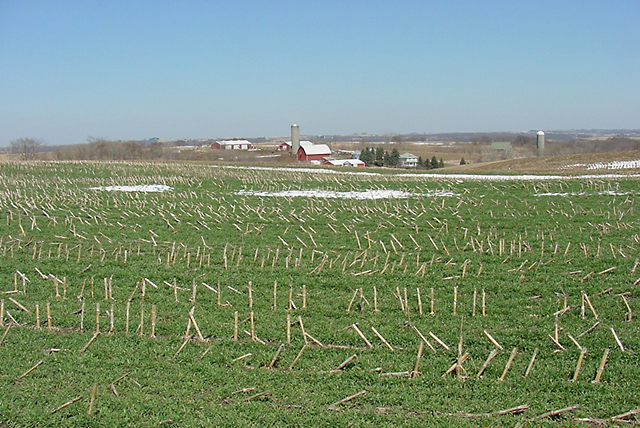Winter rye is prized for its versatility. It is a source of grain and also a forage and ground cover that protects the soil from erosion by wind and rain. But the benefits of winter rye don’t stop there.
A series of studies, begun in 2015, by a team of Agricultural Research Service (ARS) and university collaborators suggest that establishing a cover crop of winter rye between rotations of corn and soybean can reduce nitrate losses, sequester carbon, and provide a source of renewable natural gas.
Robert Malone, an agricultural engineer with the ARS National Laboratory for Agriculture and the Environment in Ames, Iowa, is coordinating the studies to evaluate rye’s potential role in the “sustainable intensification of agriculture”—an approach deemed critical to meeting growing world demand for food, feed, fiber, and fuel without overtaxing what the land and natural resources can provide.
In the latest studies, the team used a field-scale computer model to simulate rotations of corn and soybean, with or without winter rye cover crops, at 40 sites across the North Central United States, including parts of the Mississippi River Basin, which empties into the Gulf of Mexico.
Among results recently published in the journal of Environmental Research Letters:
-
-
- Establishing a winter rye cover crop between corn-soybean rotations in tile-drained fields (meaning, those using a system of underground drainage pipes to remove excess water) reduced nitrate levels in drainage water by more than 45 percent compared to rye-free fields—or about 21 and 44 kilograms per hectare, respectively.
- Across the 63-total million hectares (approximately 156 million acres) of North Central farmland that the model’s simulations encompassed, use of a winter rye cover crops on tile-drained fields translated to a 27 percent reduction in nitrate loads entering the Gulf of Mexico via the Mississippi River basin.
-
Nitrate poses an environmental concern when it goes unused by crop plants and escapes into streams, river, lakes and other bodies of surface water, compromising water quality and helping fuel algal blooms. The subsequent death and decay of the algae in these blooms consumes oxygen, killing or driving off fish and other aquatic life.
In coastal waters like the Gulf of Mexico, this condition is known as hypoxia, and it creates a “dead zone” spanning several thousand square miles, a size that can exact a costly toll on commercial fisheries and other associated industries. This summer, for example, the Gulf’s dead zone is forecasted to cover 4,155 square miles.
“A variety of factors—including the effects of excess nutrients and water-body stratification (layering) due to saline or temperature gradients—can create hypoxic conditions. In North America, the size of the hypoxic area in the Gulf of Mexico correlates strongly with spring nitrate-nitrogen loads from the Mississippi River,” explained Malone, who collaborates on the modelling studies with 15 other researchers from three ARS laboratories and four universities.
Climate-change may increase the likelihood of hypoxic conditions in the Gulf of Mexico, lending urgency to U.S. Environmental Protection Agency task force efforts to reduce nitrogen and phosphorous loads from the Mississippi River basin by 45 percent by 2035.
“The use of cover crops such as winter rye in corn-soybean rotations in the North-Central U.S. is one of the most promising conservation strategies for reducing nitrate loads to streams and rivers that discharge into the Mississippi River,” according to Malone.
In addition to curbing nitrate losses, winter rye cover crops may also have a role to play in capturing (or, “sequestering”) carbon.
According to the model’s simulations, establishing winter rye cover crops in corn-soybean rotations across the North Central U.S. could produce more than 18 million metric tonnes (19.8 million tons) of field residue, called “biomass.” That rye residue, in turn, has potential to yield 210 million megajoules of energy annually—the equivalent energy content of 2.3 billion gallons of ethanol—were it to be converted into bio-methane gas using anaerobic digesters.
The simulations also indicate that in the bio-methane production process, a standard filtration step called “upgrading” could enable the removal and capture 7.5 million tonnes (8.3 million tons) annually of carbon dioxide, preventing its release back into the atmosphere when the biogas is burned for power or heat and creating a carbon sequestration benefit for farmers.
The researchers don’t view winter rye cover crops as a proverbial “magic bullet” for managing nitrogen and improving the environment, however. Rather, it’s likely to be integrated with other measures, including the use of saturated riparian buffers, controlled drainage, wetlands and bioreactors.
“Combined conservation practices such as winter rye cover crops and edge-of-field practices like using the saturated buffers are sometimes called ‘stacked practices,’ and they may reduce nitrogen loss more than when each practice is used individually,” said Malone.
Along with colleagues in Ames, Malone co-authored the Environmental Research Letters paper together with scientists from the ARS Soil and Water Management Research Unit, the ARS Arid-Land Agricultural Research Center, Pennsylvania State University, Iowa State University, McGill University and Purdue University.
Originally published by the Agricultural Research Service on August 10, 2023.
The Agricultural Research Service is the U.S. Department of Agriculture’s chief scientific in-house research agency. Daily, ARS focuses on solutions to agricultural problems affecting America. Each dollar invested in U.S. agricultural research results in $20 of economic impact.
Contact: Jan Suszkiw
Email: Jan.Suszkiw@usda.gov
Learn more about the benefits of healthy soil, organic certification, and OCIA International.
- Healthy Soil: Cultivating healthy soil requires establishing ecological balance and increasing biological diversity. But how can you establish healthy soil on your farm?
- Certification Process: What does the organic certification process ential? At OCIA, we are committed to making the process as seamless as possible.
- Why Certify with OCIA?: Choosing an organic certification agency is one of the most important points in an operator’s certification process. Let us tell you why OCIA is the right choice for you.

